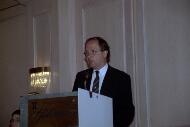| SOFT - TIAFT 1998 | Scientific Session 7 | Friday October 9, 1998 |
| DETERMINATION OF 2-OXO-3-HYDROXY-LSD IN URINE BY GC/MS | |
 |
Alain G. Verstraete, Eric J. Van de Velde Laboratory of Clinical Biology, University Hospital, De Pintelaan 185, B-9000 Gent, Belgium |
| Only 1 to 3 % of an LSD dose (typically 50 µg) is excreted unchanged in urine. Therefore urinary LSD concentrations are very low (rarely above 10 ng/mL) and detectable for only 12 - 24 hours after intake (at a cutoff of 0.5 ng/mL). Recently, certain unpublished LC/MS/MS observations have indicated that 2-oxo-3-hydroxy-LSD is present in urine at much higher concentrations. The cross reactivity of 2-oxo-3-hydroxy-LSD in the EMIT, CEDIA and KIMS immunoassays is 1.7, 1.8 and 11 % respectively.
LSD and 2-oxo-3-hydroxy-LSD have been quantified in urine by GC/MS (Hewlett Packard 5970) after solid phase extraction on SPEC.PLUS MP1 (3 mL, 30 mg, Ansys, Irvine, CA, USA) disks using the method recommended for amphetamines and derivatization by BSTFA. Lysergic acid methyl propyl amide (LAMPA) was used as the internal standard for quantitation. For 2-oxo-3-hydroxy-LSD-diTMS, m/z of 309 and 499 were used as quantitation and confirmation ions respectively. In four samples containing between 0.26 and 7.0 ng/mL of LSD, 2-oxo-3-hydroxy-LSD concentrations between 8.0 and 28.5 ng/mL were found, i.e. between 4.3 and 41 times higher than the LSD concentration. High peaks of 2-oxo-3-hydroxy-LSD was also observed in full scan chromatograms of two more samples that we analyzed some years ago. The concentrations were not higher after enzymatic hydrolysis, which suggests that 2-oxo-3-hydroxy-LSD is not conjugated. These results indicate that 2-oxo-3-hydroxy-LSD in present in urine at higher concentrations than LSD, which will facilitate the confirmation of positive screenings and could increase the detection time. In conclusion, we developed a simple GC/MS method for quantifying 2-oxo-3-hydroxy-LSD in urine and found it at concentrations 4 to 40 times higher than LSD. Further studies will be needed to confirm these results on a larger number of samples and to document the excretion kinetics of this metabolite. |
 Previous Abstract |
Friday Index |
 Next Abstract |
Further information: tiaft98@aol.com or spiehleraa@aol.com
TIAFT & CBFT 1995 - 1997 All Rights Reserved